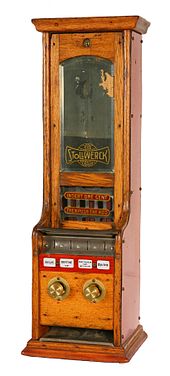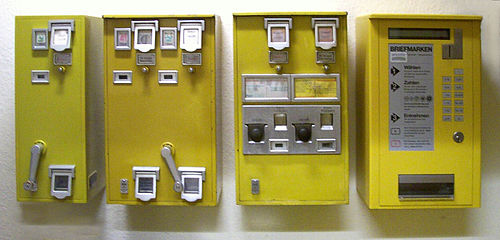Vending machine
A vending machine is a device that goods in self-service issues for payment or provides access to the restricted areas or services.
Areas of application
Vending machines are mainly used in the sale of items with a low unit price. In many countries machines are used to pay at petrol stations . A machine saves staff and works around the clock. The shop closing law in Germany does not apply. A vending machine enables sale to anyone and the vending machine sales are attributed to the retail trade. Its disadvantage is that customers do not have a direct point of contact in the event of problems and machines can be difficult to use for certain groups of users. From the point of view of retail psychology , the machine operator will compensate for some of the disadvantages of the vending machine: no discount or credit granted, no complaints, no individual service. The vending machine cannot initiate a sale on its own; a favorable installation location with high pedestrian frequency and goods suitable for spontaneous purchases must be selected. The advertising is related to the machine: for example, through conspicuous color design, neon letters or flashing signs, sometimes through subtle acoustic signals. Sales by means of vending machine sales are familiar with numerous business specifics (location, price, credit, service, organizational and information policy, difficult demographic or psychological market segmentation). Specific problems of loading optimization and profitability calculation must also be solved. The economic limits of vending machine sales are the lack of energy supply and monitoring options.
history
The Greek Heron of Alexandria constructed the first traditional vending machine in the 1st century on the basis of the principle of communicating vessels he had discovered (see Heron's fountain ). After inserting a tetradrachm coin, he gave off the same volume of holy water.
The first vending machines with the principle of the coin insertion existed in English pubs as early as 1615. It was the so-called "honesty tobacco container" ( English honesty-tobacco-boxes ) for pipe tobacco. Carl Ade was granted a patent in Berlin in 1867 for the first satisfactorily functioning vending machine, but it is not certain whether it ever went into operation. Percival Everitt received a patent for postcard machines in London in April 1883. Emil Wirba and Ferdinand Uecker received the patent for an “automatic sales container for cigars” on May 2, 1883 (German Reich patent 24721). The cigars stacked loosely in the device are conveyed to the dispenser by a paddle roller after a locking mechanism is unlocked by the inserted coin and the roller is moved by pressing the button on the lid of the device. The era of German coin-operated machines began with the vending machines from Gebr. Stollwerck . Inspired by a study trip to America, Ludwig Stollwerck implemented the idea in 1887 of filling vending machines with samples and chocolate. Together with Max Sielaff and Theodor Bergmann , he developed the first vending machine models “Rhenania” and “Merkur” with cast iron housings from Bergmann and a patented coin checking system from Max Sielaff. After smaller wall-mounted machines with two openings for the sale of chocolate and sweets, which were already widespread in 1887, large free-standing machines with richly decorated housings were added in the following years. In 1893, 15,000 machines were installed in Germany, in 1894 there were 4,000 machines in New York alone. The origin of the vending machines in Germany goes back to Stollwerck.
The founder of the "Adams Gum Company", Thomas Adams , set up the first machines for "Tutti-Frutti-Chewing Gum" in New York City in 1888 . The Deutsche Automaten-Gesellschaft Stollwerck & Co. (DAG) in Cologne followed in 1894, organizing the distribution of all coin-operated machines on a large scale and taking over the production, installation, assembly and maintenance of the machines. Ludwig Stollwerck attached great importance to shapely design: The "Merkur-Automat" was considered a real gem, both in its external architectural form and in its interior fittings, and immediately caught the eye. The large "Merkur machine" from around 1890 offered up to 12 different items for sale. Around 1895 there was a wide range of large standing machines under the names “Merkur”, “Rhenania”, “Hermes”, “Oktava” and “Juno”, which, apart from the different number of openings, differed only in the slightly modified gable shape . The separation of the vending machine business was necessary to prevent the loss of the reputation of the Stollwerck products due to legal disputes in connection with the vending machines. Criticism of vending machines was publicly justified with public health concerns, and the Church raised concerns about the Sunday sale of confectionery and the possible temptation of believers during Lent. Competitors in particular complained in court of violations of local trade regulations, sales bans on Sundays and public holidays and even incitement to crime by children who tried to get chocolate by throwing trouser buttons. The tax authorities made demands for a special taxation of machine sales.
Together with his friend John Volkmann , Stollwerck founded Volkmann, Stollwerck & Co. in New York in 1887 . Volkmann imported Stollwerck semi-finished products from Germany and had them processed into machine products in New York, which he used to equip his machines. In 1892 Volkmann produced the first Stollwerck machine for the USA. The machine sold the products: Chocolate, Dentyne Gum, Wintergreen Gum with Pepsin and Chiclets for a cent each. From 1898, Volkmann, Stollwerck & Co. opened vending machine restaurants in San Francisco , New York, Philadelphia, St. Louis and other American cities. Until the First World War , Stollwerck remained the market leader for chocolate machines in the USA.
In 1902, Joseph Horn and Frank Hardart opened a self-service establishment in Philadelphia, in which the food and dishes were only offered in vending machines. The Horn & Hardart Automats expanded in 1912 to New York and was in the 1940s and 1950s, with more than 180 branches the world's largest restaurant chain, their last branch closed in 1991. By 1920, became the first drink machine built abfüllten drinks during cup. In 1926, the American William Rowe invented the cigarette machine .
1930 built Mitropa vending machines for chocolate in cars of the Deutsche Reichsbahn , initially in vehicles on the routes from Berlin to Frankfurt and Munich wrong.
Legal issues
The goods in a vending machine are considered a binding offer by the machine operator in accordance with Section 145 BGB . Anyone who throws the correct money into the machine in the intended manner or uses debit , credit or credit cards and properly activates the intended mechanism accepts the offer by implicit action ( acceptance in accordance with Section 147 (1) BGB) and thus includes one Purchase contract with the operator, provided the machine works and stocks are sufficient. Coin validators and banknote control devices prevent payment with counterfeit money . Anyone who has thrown in the requested money and still does not receive the goods automatically puts the vending machine operator in default of delivery due to the sales contract that has been concluded .
measure up
Every two years, manufacturers of vending machines, vending cups, filling products, payment systems and service providers present their innovations at the Eu'Vend trade fair in Cologne.
Types of self-service machines
Different goods are offered by means of vending machines, which makes it possible for the customer to receive the article at certain locations regardless of shop opening times. Customer requests are fulfilled every day in 24 hours without paying a permanent sales force. Time-bound items such as any type of tickets, condoms, worms, money or change can be provided. The product options range from cigarettes and grave lights to calling cards.
Fruit vending machine (1961)
Bicycle hose machine , also called hose machine
Postage stamp machine of the Deutsche Post AG
First aid machine
Automatic access to the men's room
ÖBB ticket machine
Historic German machine for platform tickets
Machine for ballerina shoes
Fresh eggs and other products from a farm shop
Vending machine with sweets and chocolate bars
Automatic wormer for fish bait
Web links
Individual evidence
- ↑ See Hans-Otto Schenk: Der Automatenvertrieb. Theoretical, empirical and literary studies on a "forgotten" type of retail trade , discussion article no. 115 of the Department of Economics at the University of Duisburg, Duisburg 1988.
- ↑ See Hans-Otto Schenk: Psychologie im Handel , 2nd edition, Munich-Vienna 2007, ISBN 978-3-486-58379-3 .
- ↑ Patrick Robertson, What was the first time and when? , 1977, p. 236 f.
- ↑ Deutsches Museum, When the penny falls: coin-operated machines, yesterday and today , 1988, p. 11
- ^ Uwe Spiekermann : Basis of the consumer society. Origin and development of modern retail trade in Germany 1850–1914 . CH Beck, 1999, ISBN 978-3-406-44874-4
- ↑ Deutsches Museum, When the penny falls: coin-operated machines, yesterday and today , 1988, p. 2
- ↑ Audrey Carol McCool / Fred A. Smith / David L. Tucker, Dimensions of noncommercial foodservice management , 1994, p. 41
- ↑ RWWA, Dept. 208: Stollwerck AG , documents Deutsche Automatengesellschaft, Cologne, (DAG)
- ↑ Martin Loiperdinger, Film & Schokolade: Stollwerck's Business with Living Images , 1999, p. 22
- ↑ Deutsches Museum, When the penny falls: coin-operated machines, yesterday and today , 1988, p. 2
- ↑ Bruno Kuske: 100 Years of Stollwerck History 1839–1939 . Cologne 1939.
- ^ Mira Wilkins: The History of Foreign Investment in the United States to 1914 . Harvard Studies, 1989, ISBN 0-674-39666-9 .
- ↑ Deutsche Reichsbahn-Gesellschaft (Ed.): Official Gazette of the Reichsbahndirektion in Mainz of May 31, 1930, No. 28. Announcement No. 385, p. 174.
- ^ Gerti Donhauser, Contract Law / Law of Obligations / Property Law , 2004, p. 29























